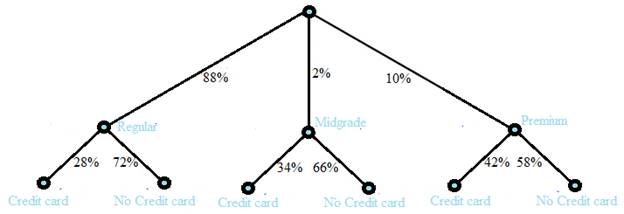
(a)
Represent this chance process with Tree diagram.
(a)
Explanation of Solution
Given information:
Fuel purchased by automobile drivers:
88% bought regular gasoline.
2% bought midgrade gas.
10% bought premium gas.
Customers paid with Credit card:
28% bought regular gasoline.
34% bought midgrade gas.
42% bought premium gas.
First level:
First level consists of three types of gasoline:
Regular, midgrade and premium
Thus,
The first level requires three children:
Regular, midgrade and premium
Second level:
In this level, there are two types of payment methods:
Credit card or No Credit card (other payment method)
Thus,
The second level consists of two children per child at the first level i.e.; Credit card and No Credit Card.
The required tree diagram can be drawn as:

(b)
(b)
Answer to Problem 81E
Probability that the customer paid with a credit card is 0.2952.
Explanation of Solution
Given information:
Fuel purchased by automobile drivers:
88% bought regular gasoline.
2% bought midgrade gas.
10% bought premium gas.
Customers paid with Credit card:
28% bought regular gasoline.
34% bought midgrade gas.
42% bought premium gas.
Calculations:
According to the general multiplication rule,
According to the
Let
R: Regular gasoline
M: Midgrade gas
P: Premium gas
C: Credit card
N: No Credit card
Now,
The corresponding probabilities:
Probability for the customer purchased regular gasoline,
Probability for the customer purchased midgrade gas,
Probability for the customer purchased premium gas,
Probability for the customer purchased regular gasoline paid with Credit card,
Probability for the customer purchased midgrade gas paid with Credit card,
Probability for the customer purchased premium gas paid with Credit card,
Apply general multiplication rule:
Probability for the customer paid with Credit card and purchased regular gasoline,
Probability for the customer paid with Credit card and purchased midgrade gas,
Probability for the customer paid with Credit card and purchased premium gas,
Since the vehicles cannot be filled up with two types of gas at same time.
Apply the addition rule for mutually exclusive events:
Thus,
Probability for customer paid with a Credit card is 0.2952.
(c)
Conditional probability for the customer paid with credit card bought premium gas.
(c)
Answer to Problem 81E
Probability that the customer paid with credit card bought premium gas is approx. 0.1423.
Explanation of Solution
Given information:
Fuel purchased by automobile drivers:
88% bought regular gasoline.
2% bought midgrade gas
10% bought premium gas
Customers paid with Credit card:
28% bought regular gasoline.
34% bought midgrade gas
42% bought premium gas
Calculations:
According to the conditional probability,
From Part (b),
We have
Probability for the customer paid with a credit card,
Probability for the customer paid with credit card and purchased premium gas,
Apply the conditional probability:
Thus,
The probability for customer paid with credit card purchased premium gas is approx. 0.1423.
Chapter 5 Solutions
PRACTICE OF STATISTICS F/AP EXAM
Additional Math Textbook Solutions
Essentials of Statistics, Books a la Carte Edition (5th Edition)
Basic Business Statistics, Student Value Edition (13th Edition)
Statistical Reasoning for Everyday Life (5th Edition)
Intro Stats, Books a la Carte Edition (5th Edition)
Statistics for Business and Economics (13th Edition)
 MATLAB: An Introduction with ApplicationsStatisticsISBN:9781119256830Author:Amos GilatPublisher:John Wiley & Sons Inc
MATLAB: An Introduction with ApplicationsStatisticsISBN:9781119256830Author:Amos GilatPublisher:John Wiley & Sons Inc Probability and Statistics for Engineering and th...StatisticsISBN:9781305251809Author:Jay L. DevorePublisher:Cengage Learning
Probability and Statistics for Engineering and th...StatisticsISBN:9781305251809Author:Jay L. DevorePublisher:Cengage Learning Statistics for The Behavioral Sciences (MindTap C...StatisticsISBN:9781305504912Author:Frederick J Gravetter, Larry B. WallnauPublisher:Cengage Learning
Statistics for The Behavioral Sciences (MindTap C...StatisticsISBN:9781305504912Author:Frederick J Gravetter, Larry B. WallnauPublisher:Cengage Learning Elementary Statistics: Picturing the World (7th E...StatisticsISBN:9780134683416Author:Ron Larson, Betsy FarberPublisher:PEARSON
Elementary Statistics: Picturing the World (7th E...StatisticsISBN:9780134683416Author:Ron Larson, Betsy FarberPublisher:PEARSON The Basic Practice of StatisticsStatisticsISBN:9781319042578Author:David S. Moore, William I. Notz, Michael A. FlignerPublisher:W. H. Freeman
The Basic Practice of StatisticsStatisticsISBN:9781319042578Author:David S. Moore, William I. Notz, Michael A. FlignerPublisher:W. H. Freeman Introduction to the Practice of StatisticsStatisticsISBN:9781319013387Author:David S. Moore, George P. McCabe, Bruce A. CraigPublisher:W. H. Freeman
Introduction to the Practice of StatisticsStatisticsISBN:9781319013387Author:David S. Moore, George P. McCabe, Bruce A. CraigPublisher:W. H. Freeman





